We know, we know. Screen time gets blamed for everything. Burnout, bad sleep, digital dating disasters. But is it also to blame for a lackluster sex life? Or, could all those hours spent online actually be turning up the heat?
To find out, we surveyed over 3,000 sexually active Americans, asking how many hours they spend on screens each day (for both work and play) and how often they have sex in a typical month. We then analyzed the data to see whether screen time and sexual activity are truly connected, and how that relationship plays out both nationally and state by state. Finally, we asked participants how they think screen use affects their desire for sex, revealing a surprising disconnect between perception and reality when it comes to tech and intimacy. From state-by-state breakdowns to Gen Z insights, here’s what the data really says about sex in the age of being chronically online.
How Screen Time Is Shaping America’s Sex Lives
More Screen Time Means More Sex
Turns out, your screen addiction might not be killing your sex life after all. Overall survey results show a surprising twist: the more time Americans spend in front of screens or online, the more sex they tend to have. There is a positive correlation between daily screen time and frequency of having sex, so as daily screen time increases, sexual frequency also increases.
Why? For starters, more screen time often means more access to dating apps, porn content, and sexting, which can all lead to real-world action. Screens might be serving as the foreplay, not the buzzkill.
The screen-sex link holds true across the board. According to survey results, both singles and people in relationships tend to have more sex as their screen time increases. But the connection is stronger for couples. While singles see a modest uptick, partnered folks show a more pronounced correlation, suggesting that more time online might actually be helping heat things up.
What’s more, people who use screens less for work—either not at all or only part-time—show a stronger link between screen use and sexual activity. Meanwhile, those glued to a screen 9-to-5 see a weaker connection. So it’s not just screen time, but screen fatigue. If your brain’s fried from a full day of spreadsheets, chances are you’re less in the mood later on. But a little scrolling after a low-tech workday? That might just spark something. Now let’s see how the results shift when we zoom in on specific states.
States With High Screen Time That Report More Sex
- Tennessee – Daily Screen Hours: 11.2; Sex Per Month: 10.6 times
- Mississippi – Daily Screen Hours: 11.7; Sex Per Month: 9.7 times
- Arkansas – Daily Screen Hours: 11.4; Sex Per Month: 9.8 times
National Average – Daily Screen Hours: 10.8; Sex Per Month: 7.9 times
If you’re in certain Southern states, your screen time might be doing more than keeping you entertained—it could be boosting your sex life. Tennessee, Mississippi, and Arkansas top the list for states where residents not only spend more time glued to their screens but also report having more sex than the national average. Tennessee leads with over 11 hours of screen time a day and nearly 40% more sex than the average American (10.6 times per month). In Mississippi, screen time is even higher at 11.7 hours a day, paired with 23.5% more sex. And Arkansas isn’t far behind, with residents clocking 11.4 screen hours and nearly 25% more sex than average.
States with High Screen Time That Report Less Sex
- Florida – Daily Screen Hours: 11.9; Sex Per Month: 6.0 times
- Georgia – Daily Screen Hours: 12.3; Sex Per Month: 6.5 times
- Colorado – Daily Screen Hours: 11.2; Sex Per Month: 6.6 times
National Average – Daily Screen Hours: 10.8; Sex Per Month: 7.9 times
More screen time doesn’t always mean more sex—just ask Florida, Georgia, and Colorado. Despite logging some of the highest daily screen hours in the country, residents in these states are having significantly less sex than the national average. Florida tops the list with nearly 12 hours of screen time a day and 24% less sex than the study’s average (6 times per month). Georgia isn’t far behind, with even more screen time and 17% less bedroom activity. And in Colorado, the numbers tell a similar story: higher screen use, lower intimacy.
How People Perceive Screen Time to Impact Their Sex Lives
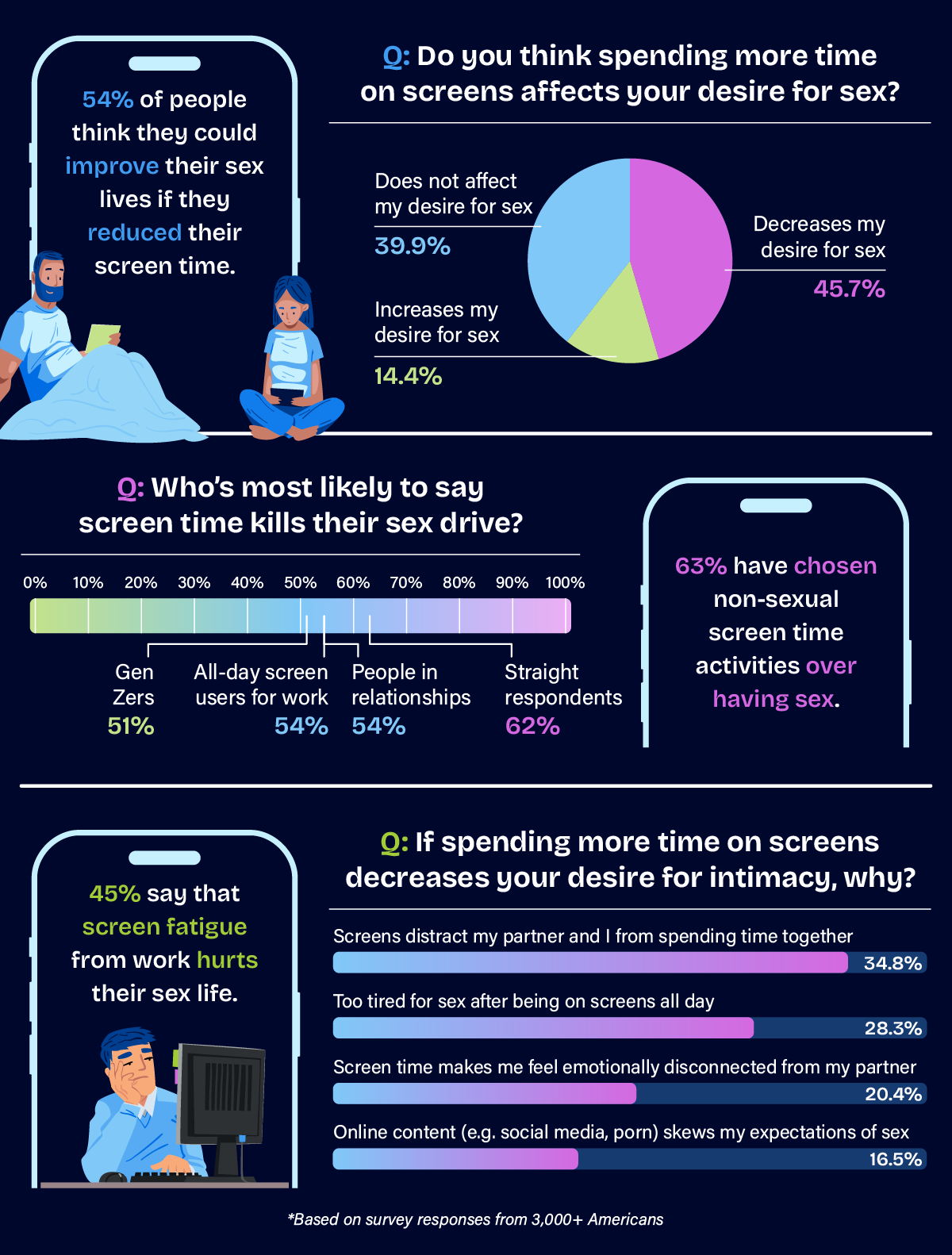
Next, we asked respondents how they think their screen time impacts how often they have sex. Despite what the numbers say above, most people feel like screen time is sabotaging their sex lives. The largest share of people (46%) believe that spending more time online and on screens actually decreases their desire for sex, while only 14.4% think it boosts it. That’s a pretty striking mismatch considering the earlier finding: more screen time is actually associated with more sex, not less. What’s more, 54% of people think they could improve their sex lives if they reduced their screen time.
So what’s behind this disconnect? For many, it’s about distraction, not desire. Among those who feel that screen time hurts their sex life, the most common explanation is, “My partner and I get too distracted by screens and spend less time engaging with each other,” followed by “being on screens all day makes me feel physically drained and too tired to have sex.” Screen fatigue from work is a major factor: 45% of people say that staring at screens all day for work zaps their libido by the time night rolls around.
Who’s Most Likely to Say Screen Time Kills Their Sex Drive?
Some groups feel the drag of screen time more than others. People in relationships are more than twice as likely as singles to say screen time lowers their desire for sex (54% vs. 22%), possibly because they’re trying to maintain intimacy with someone who’s often just a few feet away, but emotionally checked out.
Meanwhile, Gen Zers (51%) and straight respondents (62%) are also among the most likely to say screen time kills the mood. Straight people, in particular, are nearly twice as likely as LGBTQ+ respondents to feel that screen use dampens physical intimacy — a difference that might reflect relationship norms, tech habits, or communication styles.
The Gap Between Perception and Reality
Here’s the catch: even though many people believe screens are hurting their sex lives, their data says otherwise. When we look at actual behaviors, not just self-reports, there’s a positive correlation between screen time and sexual frequency. More screen time is linked to more sex.
The likely reason? While screens can be a distraction, they also open up new ways to connect — from dating apps and sexting to porn and watching steamy tv shows. Plus, after a day spent drowning in screens for work, the craving for real, physical closeness can intensify, making sex feel like a needed break from digital overload. So while people think their screens are getting in the way, in many cases, they might actually be making intimacy more accessible.
Sex or TikTok? What Americans Are Really Choosing
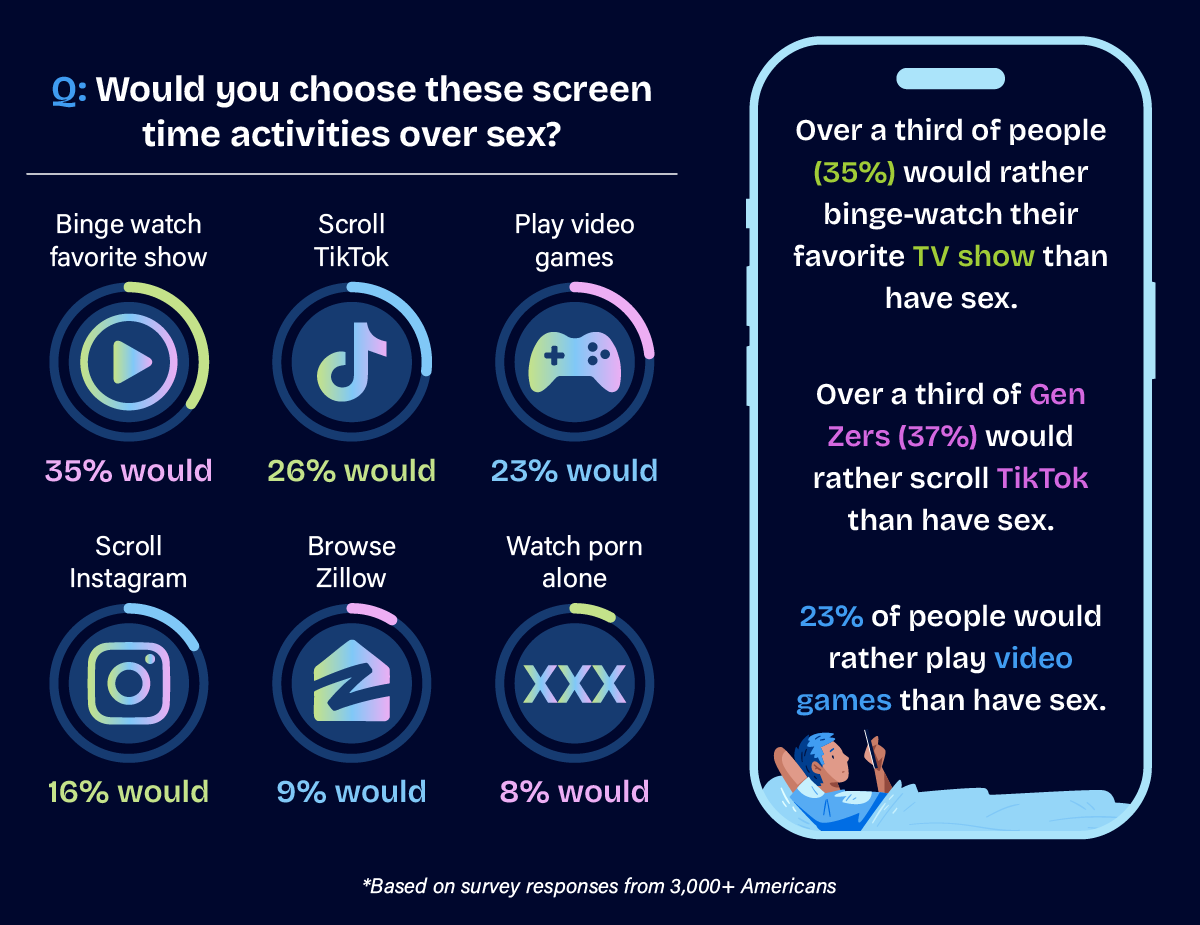
For all the digital tools that might be helping our sex lives, screens still pose some major competition, especially when it comes to how we choose to spend our downtime.
A full 63% of people admit to picking non-sexual screen activities over sex. For many, that means curling up with their comfort show instead of getting frisky. More than a third of respondents (35%) say they’d rather binge-watch TV than have sex. The gender gap is also telling. 43% of cis women would rather hit “next episode” than get it on, compared to just 27% of cis men. And if TikTok is your love language, you’re not alone: over a third of Gen Zers (37%) — and 1 in 3 cis women — would rather scroll TikTok than have sex.
Video games also come into play. Nearly 1 in 4 people (23%) say they’d prefer gaming over sex, with Gen Z once again leading the charge. 31% of them would choose the controller over getting under the covers. In a culture of constant digital stimulation, it seems like sex is just another option in the entertainment lineup, and sometimes, it loses to the algorithm.
How Technology Is Shaping America’s Sex Lives
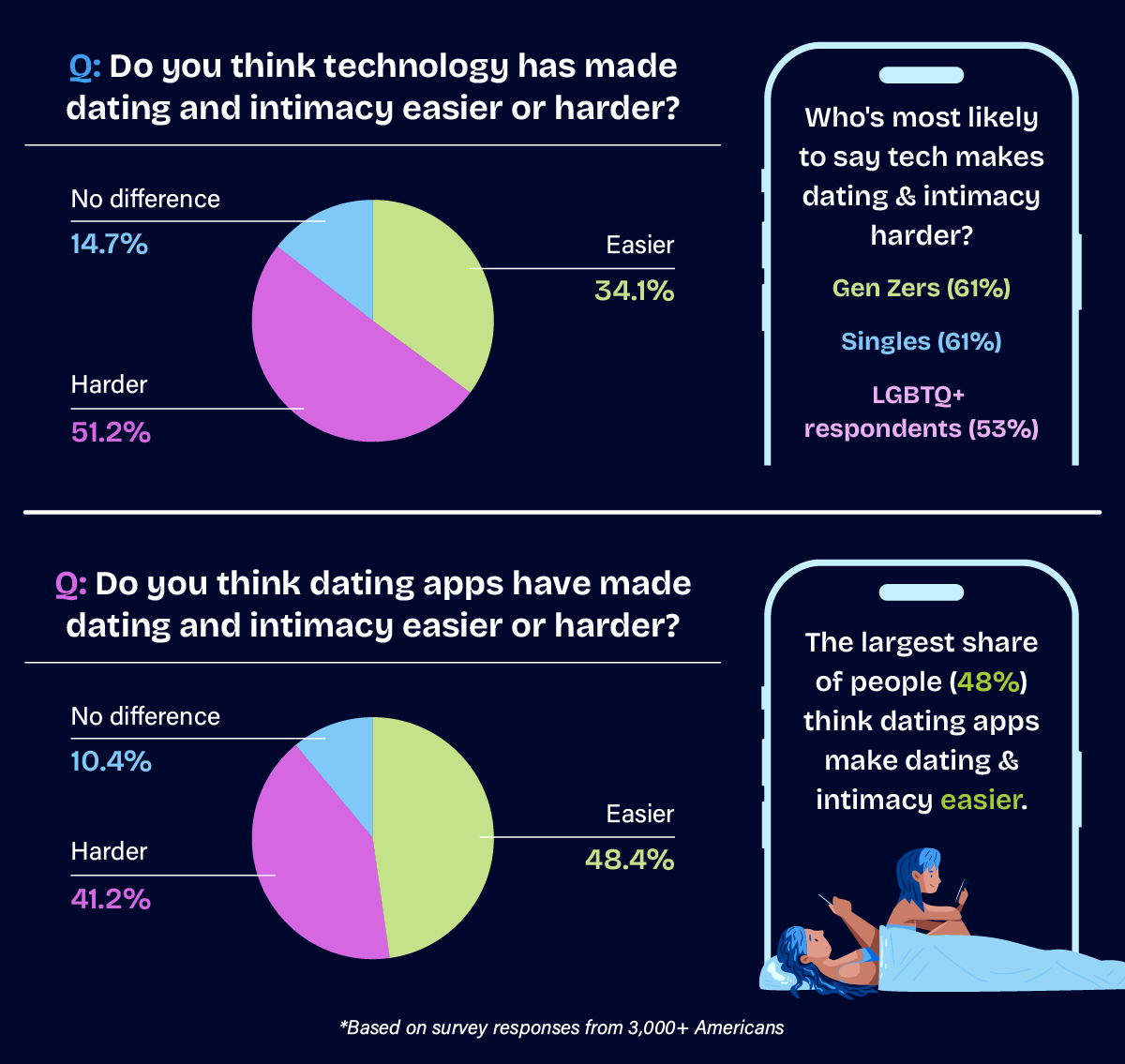
Ask people how tech is affecting their love lives, and the answer is… complex. Over half of respondents (51%) say technology has made dating and intimacy harder. The numbers are even higher among Gen Zers (61%), singles (61%), and LGBTQ+ respondents (53%) — the very groups most plugged into the digital dating world.
But when you ask people specifically about dating apps, the mood shifts. The largest share of respondents (48%) think dating apps make dating and intimacy easier.
It all comes down to what we mean by “technology.” When people say tech is ruining intimacy, they’re usually thinking about the endless scroll: social media distractions, emotional disconnection, unrealistic #couplegoals, and the general burnout that comes from too many DMs and not enough depth. But dating apps? That’s a different story. They’re seen as tools — a way to meet people, cut through awkward small talk, and connect faster, especially if you’re introverted or time-starved.
What’s Really Getting in the Way of Our Sex Lives?
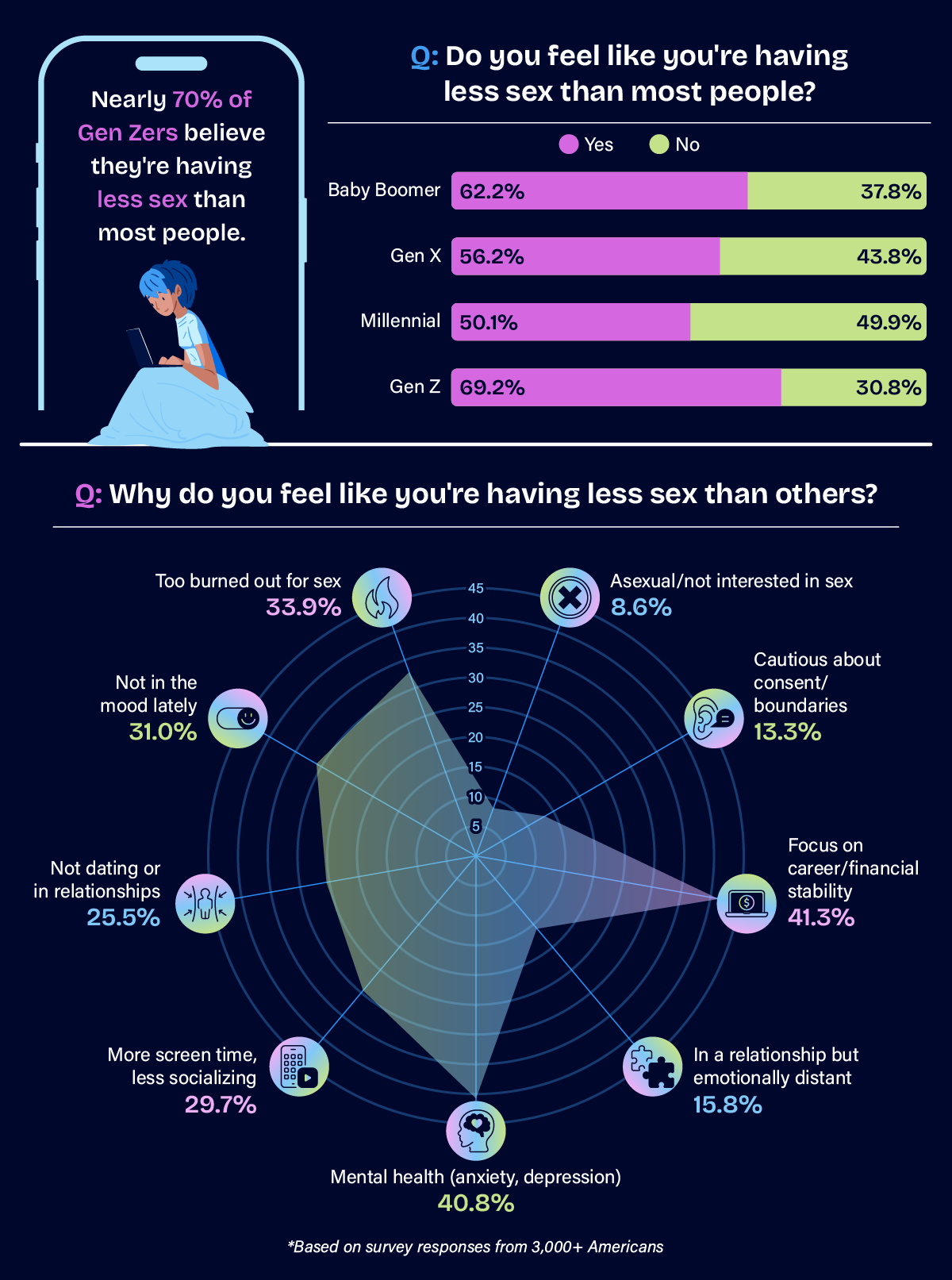
Across all respondents, over half (56%) think they’re having less sex than most people. The self-doubt is strongest among Gen Z, where nearly 70% believe they’re lagging behind in the hookup department, compared to 56% of Gen Xers and just 50% of millennials who feel the same way.
So what’s behind all this bedroom FOMO? When asked why they think they’re having less sex, people pointed to a mix of modern-life stressors and emotional burnout. Over 41% say they’re too focused on work, school, or financial stability. Nearly the same percentage blames mental health struggles like anxiety or depression. Others say they’re too exhausted for intimacy (34%), just not in the mood (31%), or stuck in a cycle of too much screen time and not enough socializing (30%).
Basically, it’s not just about libido — it’s about life. The pressure to hustle, perform, and be okay all the time is leaving people emotionally wiped and physically disconnected.
Gen Z Has the Highest Screen Time and the Most Sex
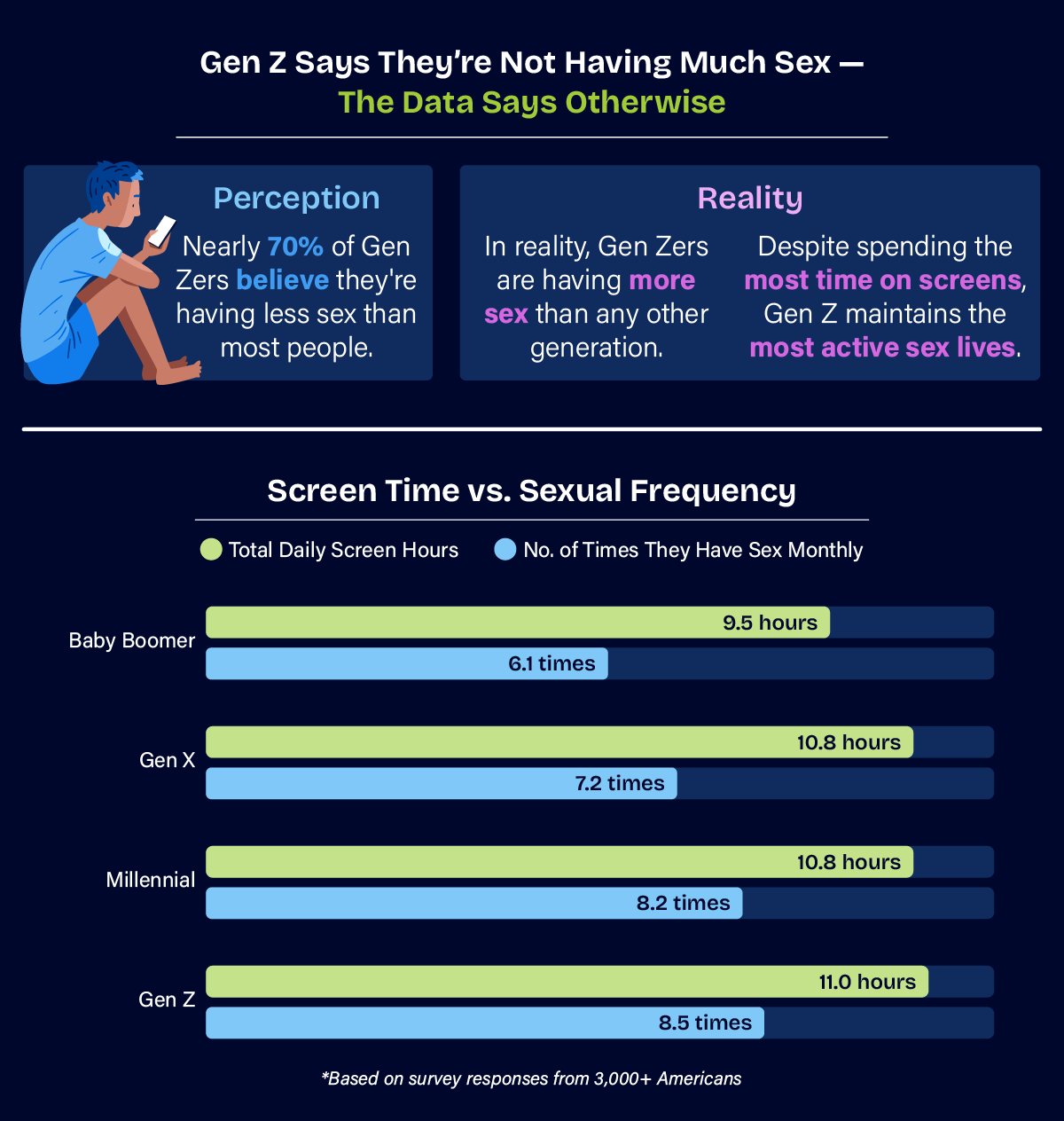
For a generation that’s hyper-connected, Gen Z seems to feel surprisingly disconnected when it comes to sex. Nearly 70% believe they’re having less sex than most people, the highest self-reported gap of any generation. When asked why, they pointed to career and financial stress (48%) and mental health struggles (42%) as the top mood killers. The burnout is real.
But in reality, Gen Z is actually having the most sex. According to the data, they average 8.5 times per month, slightly more than millennials (8.2) and Gen Xers (7.2). They also report the highest daily screen time at 11 hours a day. Despite spending the most time on screens — or maybe even because they’re so socially connected through them — Gen Z maintains the most active sex lives across generations.
Final Thoughts
So, is screen time helping or hurting our sex lives? At the end of the scroll, the answer isn’t black and white.
Dr. Evan Goldstein sums it up well: “These findings were interesting yet unexpected. We anticipated that increased screen time would negatively impact intimacy, but the data tells a different story. What stands out most is the disconnect between perception and reality. While 45.7% of respondents believe screen time decreases their sexual desire, the data shows a positive correlation between daily screen time and sexual frequency. This suggests the issue isn’t screen time itself, but rather how technology has reshaped the way we connect. The data around whether technology and dating apps have made intimacy easier or harder highlight this tension.”
Of course, sex isn’t just about screen time. It’s about how we feel in our bodies, how we connect with others, and whether we’re able to show up fully, physically and emotionally. With a holistic approach to sexual wellness, Bespoke Surgical is helping people feel confident, supported, and in tune with their bodies. Because no matter how many hours we spend online, intimacy still starts from within.
Methodology
The insights in this study are based on a survey of 3,048 sexually active Americans, ages 18 to 77, conducted across 44 states. Responses from Alaska, Montana, North Dakota, South Dakota, Vermont, and Wyoming were excluded due to insufficient sample sizes. The survey was conducted between April 8 and April 17, 2025.
To calculate total daily screen time, respondents were asked two questions: “On average, how many hours per day do you spend on a computer, tablet, or phone for work or school?” and “On average, how many hours per day do you spend on a computer, tablet, or phone for non-work activities (e.g., social media, streaming, dating apps, gaming, online shopping, etc.)?” These responses were combined to determine each respondent’s total daily screen time.
To measure sexual frequency, respondents were asked, “How many times do you have sex in a typical month?” We then ran a correlation analysis comparing daily screen time to monthly sexual frequency to determine whether the relationship was positive or negative. Respondents were also asked whether they perceived spending more time online and on screens as increasing or decreasing their desire for physical intimacy, allowing us to compare their perceptions with their actual reported behaviors.
About the Author

Consistent, proactive, and thoughtful healthcare is not only a priority, it is a demand by men who live well. Bespoke Surgical is built on this understanding. Today's modern, urban male has become adept at making the most of life, believing in living fully and completely in all aspects of work, fitness, relationships, and family. This makes excellent health more important than ever.
Join Our Newsletter
Subscribe to receive exclusive content, new product information, and the latest news.
Featured products
Read More
Education
The Ultimate Guide to Anal Hygiene
So let me paint a morning, any morning, where you’re rushing out to work or...
Uncategorized
What LGBTQ+ Patients Reveal—and Hide—from Their Doctors
Navigating the healthcare system isn’t always straightforward, especially for LGBTQ+ individuals, who often face unique...
Health
What to Do if You Have a Ruptured Hemorrhoid
A ruptured hemorrhoid is exactly what it sounds like. When you have a hemorrhoid that...
